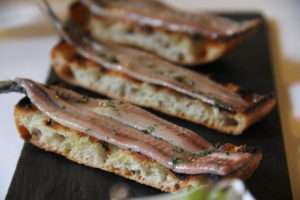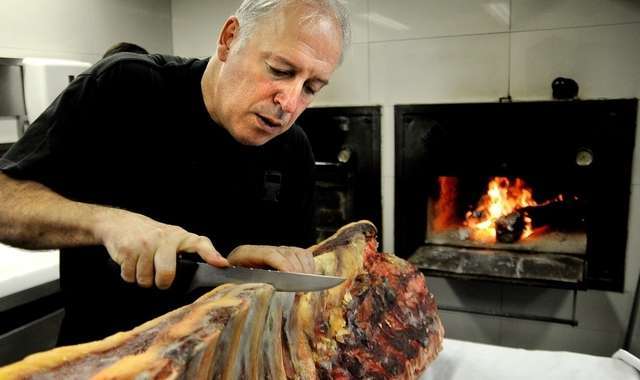By Sofia Perez
[Published by Zester Daily, September 22, 2016]
When my friend Andoni Luis Aduriz first invited me to dinner in Spain’s Basque countryside years ago, I knew the food would be wonderful. Aduriz is the chef at San Sebastián’s Mugaritz, one of the world’s most famous restaurants, so he knows cooking. But I’ll admit I had my doubts when he described the tasting menu we’d be having at Etxebarri, in the town of Atxondo. “Every dish has at least one grilled or smoked component,” he informed me.
Fast-forward to a grilled egg yolk, the bright golden orb quivering over a bed of zizas (chanterelles). Marbled slices of housemade chorizo, ibérico pork streaked fire-engine red with smoked paprika. Grilled baby octopi the size of large grapes, their flesh tinged with the slightest char. The nacreous iridescence of grilled bacalao. By the time we got to dessert—grilled puff pastry, topped with smoked-milk ice cream—I couldn’t help but laugh. At myself.
A Chef Influenced by Place
Though that meal happened more than a decade ago, the memory remains as vibrant as ever. Who was this person who’d created such ethereal food using the most elemental tool of all? I returned to Atxondo, Spain, to find out, although I knew it wouldn’t be easy. Famously shy, chef Bittor Arginzoniz, 56, would rather scrub grills than submit to a grilling himself. As the chef joined me at my table, he promptly hunched his tall frame forward, crossing his forearms protectively.
As I discovered, the best way to know him is to know the place he’s spent his entire life. A village straight out of Basque central casting, Atxondo is nestled at the foot of jagged limestone cliffs, its central plaza ringed by a church, a jai alai court, and several tiled-roof stone buildings—among them Etxebarri, formerly the town’s bar and general store.
Arginzoniz grew up just a few hundred yards away. “We didn’t have gas or electricity, so the cooking was done over the hearth. Mealtime was sacred then.” He’s at his most relaxed recalling the past, and even breaks into an almost-smile. “I remember those aromas, the smell of firewood, the taste of the stews the grandmothers used to make.”
Using Wood to Showcase the Food
A typical morning starts at 7 a.m., when he selects logs from a covered shed out back, pairing wood type to dish according to its aroma and how it burns. Wood is as crucial an ingredient on his menu as the food in his walk-in. To hear him tell it, there’s even a kind of poetry to it. “It evokes nature and freedom. Sacrifice and reward. Being fully yourself.”
Trees have been at the center of Arginzoniz’s entire life. His first job was as a forester, followed by a long stint at a local paper mill. All the while, he honed his culinary skills. As he showed me around the restaurant, bought in 1989, he explained why he focuses on this one technique. “It intensifies the flavor of whatever you cook.” His food proves the point. The aroma of burning wood is in all his dishes, but it’s there to showcase the ingredients, lifting them up while remaining modestly tucked in the background—much like the man himself.

Grilled anchovy fillets on flatbread (Photo by Amaia Zeberio)
“Everything Can Be Grilled”
My latest meal at Etxebarri held its own against the first: grilled anchovy fillets atop toasted flatbread, the hint of smoke mellowing the fish’s bold personality; coquinas—Lilliputian clams—in their briny broth, kissed by the hearth’s vapors; and that same smoked-milk ice cream I’d tasted years ago, this time over grilled berries. Scribbling my impressions in a notebook, I wished English had more synonyms for “delicate.”
Although Arginizoniz can sear a rib eye with the best of them, he works wonders with ingredients that aren’t commonly grilled, like caviar and percebes (gooseneck barnacles). His best-known dish, angulas (baby eels), was also his white whale for a time. After a food critic told him he couldn’t possibly grill them—each angula is shaped like cooked linguine and twice as slippery—Arginzoniz was determined to prove him wrong. Working with a stainless-steel manufacturer, he designed a mesh sauté pan to cradle the eels as they cook. “Everything can be grilled, if you have the right tools.”
A Man of Innovation
He’s dreamed up other contraptions, too—a fine-meshed sieve for caviar, a latticed basket for egg yolks—but his greatest invention is the grill itself. Running the length of one wall, six separate racks are rigged to pulleys and lifted and lowered over the flat surfaces that hold the embers. “In this way, I control the fire, instead of letting it control me.”
As he demonstrated moving the racks individually, it was clear he is both artisan and innovator at once. “On the surface, Bittor seems like a man who’s closed off,” said Mikel Zeberio, a Basque food writer and longtime friend, “but at his core, he’s a sponge. The ingredients he uses change him, not the other way around.”
International Acclaim
Though Etxebarri continues to scale the rankings of the world’s finest eateries—earning the 10th slot on Restaurant Magazine’s 2016 “50 Best” list—Arginzoniz seems immune to the accolades. His one and only restaurant is where you’ll find him most days. “What I cannot abide is for folks to travel 4,000 kilometers to get here only to learn that I’m not in the kitchen.”
Which works out well, because that’s exactly where he is most at peace. “I want to show that grilling can produce a kind of alta cocina—” He stops short, visibly annoyed at himself for referencing haute cuisine. “What is high or low, really? In the end, you either do it well, or you do it poorly. I just want the person who’s seated at the table to experience the same pleasure I feel when I’m cooking.”



